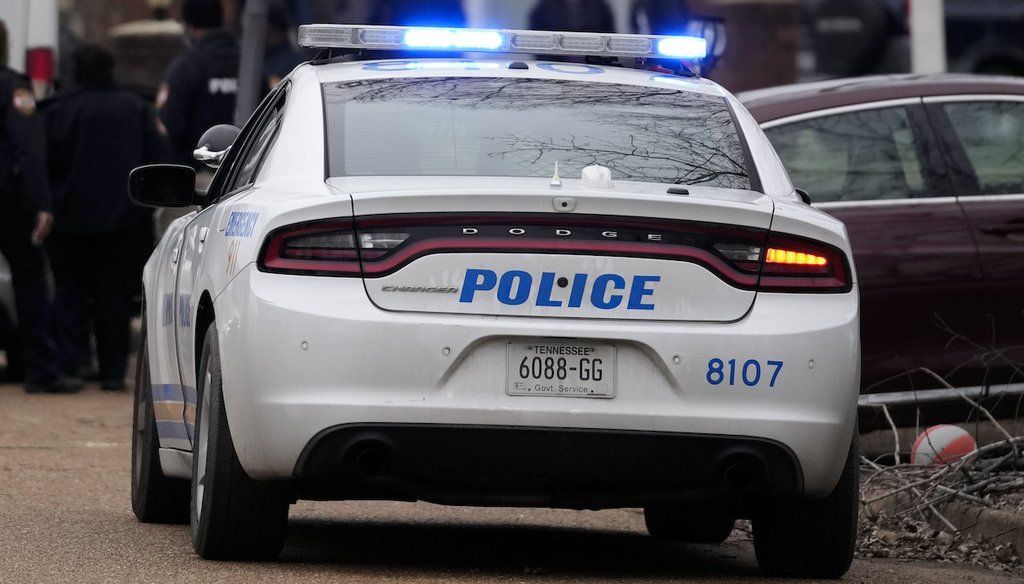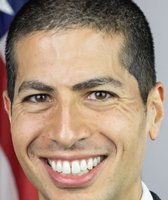Stand up for the facts!
Our only agenda is to publish the truth so you can be an informed participant in democracy.
We need your help.
I would like to contribute

A Memphis police car is part of a response to a crime scene in Memphis, Tenn., Jan. 24, 2023. (AP)
If Your Time is short
-
There is no common definition for “use of force” by police. Data about cases in which police used force is limited, as is data about cases involving “excessive” use of force.
-
Black people are disproportionately represented among those who have died following police encounters involving use of force, studies show.
-
Other studies show a police officer's race likely does not factor in whether they will use force.
-
“Use of force” is a law enforcement term; “excessive use of force” is a legal one. Most studies look at use of force, not whether the force used was “reasonable” or “excessive.”
For years, civil rights attorney Ben Crump has described "police culture" as a central factor leading to police brutality.
Tyre Nichols’ death fits that mold, he said Jan. 29 on ABC’s "This Week."
Nichols died Jan. 10, three days after a group of Memphis, Tennessee, police officers beat him following a traffic stop. Five police officers were fired and indicted on second-degree murder charges, all of them Black. On Feb. 3, a sixth officer involved in the incident was fired. He is white. The department said multiple other officers are under investigation.
Crump, who is the attorney for Nichols’ family, told "This Week" co-anchor Martha Raddatz that although the police officers who have been charged are Black, he still believes they had a racial bias against Nichols.
"I believe it’s part of the institutionalized police culture that makes it somehow allowed that they can use this type of excessive force against people of color," Crump said. "And it doesn’t matter if the officers are Black, Hispanic or white. It’s part of the culture, this biased culture that said, ‘This is allowed.’ So, just as much as those officers are responsible for the death of Tyre Nichols, so is the implicit bias police culture that exists in America."
Sign up for PolitiFact texts
Raddatz followed up: "So, you believe there was racial bias toward Tyre even though all five of those officers who are charged with second-degree murder are Black?"
"Absolutely," Crump said. "It is not the race of the police officer that is the determinant factor whether they're going to engage in excessive use of force, but it is the race of the citizen. And oftentimes it is the Black and brown citizens that bear the brunt of the brutality."
We wondered whether Crump was right — what does data show about the effect of a civilian’s race in police brutality cases? We reached out to his office for evidence, but did not hear back.
We learned that data shows that Black people are overrepresented in cases of use of force by police. And other studies suggest police officers’ race isn’t the best indicator of whether they will use force in a given situation. But there’s a difference between use of force and "excessive" use of force — and none of this data looks solely at excessive force.
"In 2023, when we can't give you an answer to this question — that in and of itself is the problem," said Robin Engel, senior vice president at the National Policing Institute.
Here’s what we know.
Data on police use of force is limited
Finding comprehensive national data on the use of force by police officers is challenging. The FBI has a national database that collects data from law enforcement. But participation is voluntary and in 2022, around 45% of law enforcement agencies participated. That represents 66% of officers in the U.S.
Other organizations have tried to breach this gap in information by creating their own databases. The Washington Post has been tracking fatal police shootings since 2015. Mapping Police Violence has a dashboard tracking cases in which law enforcement officers apply "lethal force" resulting in civilian death.
But these databases have limitations. For example, George Floyd, who was murdered in 2020 by former Minneapolis police officer Derek Chauvin, is not included in The Washington Post’s database, which tracks only police shootings. Floyd died after Chauvin knelt on his neck for more than nine minutes.
Then there’s the problem of defining "use of force." States and police departments vary as to what that term means, Engel told PolitiFact. Generally, it’s the amount of effort required for a police officer to compel an unwilling civilian to comply. This can include dragging people to a police car, pushing them to the ground or using a stun gun, such as a Taser.
Crump used the term "excessive use of force" — a legal term that describes when an officer’s use of force goes beyond what is reasonably accepted for the situation. How this term is defined can also vary by state and is often determined by courts or local police departments.
Most studies examine data pertaining to use of force by police, rather than excessive force. Available data "strictly tells us that force occurred, that someone died as a result of an interaction with a cop," said Justin Nix, a University of Nebraska, Omaha criminology professor. It's much trickier to take that data and "narrow down on what was excessive."
Studies show Black people are more likely to be killed by police
Despite these challenges, researchers have conducted multiple studies about the rates of police killings of Black and white people and have reached similar conclusions: Black people are more likely to be killed by police officers.
-
A 2020 report published in the Journal of Epidemiology and Community Health using data from The Washington Post’s database found that from 2015 to 2020 Black people were consistently killed at higher rates in police shootings than white people.
-
A 2019 study published in the Proceedings of the National Academy of Sciences journal found Black men are 2.5 times more likely to be killed by a police officer than white men and Black women are 1.4 times more likely than white women.
-
A 2015 study in the American Journal of Preventive Medicine using data from 17 states found that Black victims were overrepresented in cases of lethal force by law enforcement at a rate 2.8 times higher than white victims.
"There are clear racial disparities in the use of force on citizens and that’s a function of officers being more likely to stop and to interrogate Black citizens," Nix said. "I don't think that's up for debate anymore."
David Harris, a University of Pittsburgh criminal law professor, agreed.
"Mr. Crump is correct that the race of the citizen is what will tell you how likely it is that police will use force," Harris said.
But there’s a caveat, Engel said. These studies compare the rates of shootings or use of lethal force to the total U.S. population. Researchers are divided over the best methods of using data to determine whether the race of the civilian signals whether force will be used.
Several studies took into account other factors such as whether the civilian was armed or resisted arrest. Results in these studies are mixed.
-
A 2020 study using data from the Dallas Police Department found Black people stopped by police were two-thirds as likely as non-Black people to have a weapon drawn against them. But when they narrowed the overall group to only cases that resulted in arrest and then sorted by people who had had weapons drawn against them, researchers found that there was no statistically significant difference among races.
-
A 2017 study looked at 504 use of force incidents in which officers in a "large municipal police department" deployed Tasers or pepper spray. The study did not find a correlation between the civilian’s race and the officers’ actions. It found that Tasers were most likely deployed in cases where the civilian was deemed to be mentally disturbed, fleeing on foot or believed to be armed. The biggest predictor of whether spray was used was whether the subject was resisting officers.
-
A 2017 study looking at 1,332 shootings between 2000 and 2015 from different states found even after accounting for variables such as whether the person attacked the officer or had a weapon, police disproportionately used nonlethal force, such as slapping, grabbing or pushing, against Black people. However, when they looked only at cases in which police used their firearms, they saw no sign that police were more or less likely to shoot Black people.
Researchers note that looking just at raw numbers of incidents involving Black civilians versus those involving civilians of other races ignores biases that lead police to have more interactions with Black people in the first place. It’s important to also consider the racial makeup of the communities in which these interactions occur.
"What we do know is that there's disparity," Engel said. "Whether or not we can demonstrate that is discriminatory is another factor, and the science that we have just cannot do that."
There are limitations to what can be determined from looking at statistical patterns and trends, she said.
Studies about the race of police officers in cases of force are less common
We know there is some association between people’s race and their likelihood to die at the hands of police. But, what do we know about the race of police officers and their likelihood to use force? Experts told PolitiFact that police officers’ race seems to not significantly affect their use of force.
Greg Ridgeway, a University of Pennsylvania criminology and statistics professor, has conducted two studies looking at the race of police officers in cases involving multiple officers of different races on scene where not every officer fires their gun. One study looked at 2004 to 2006 data from the New York City Police Department and found that in police shootings with both Black and white police officers on the scene, Black officers were more likely to shoot.
His 2020 study looking at data from 55 major cities in the U.S. found that the officer’s "race appears to be unrelated to the risk of shooting more versus less rounds."
Ridgeway said the officer’s race "is probably not an excessive force predictive factor." He said he didn’t have a clear answer about why the two studies resulted in different conclusions, but suggested it could speak to the different approaches among agencies.
However, a study published in 2021 based on three years of Chicago Police Department data, found that Black officers made fewer stops, arrests and used force less often than their white counterparts, especially against Black civilians.
A 2020 study published in the American Economic Review journal analyzed 2 million 911 calls from two anonymous cities and found that white police officers used force 60% more than Black officers when responding to similar calls. And white officers were five times more likely than Black officers to use force in Black neighborhoods.
But these studies didn’t show whether police officers’ race determines their likelihood to engage specifically in force that is considered "excessive." Nix told PolitiFact this data is unavailable.
So is Crump correct?
"My gut tells me that he's probably right. Because use of all forces is disproportionate, why would not excessive force be also similarly disproportionate," Harris told PolitiFact. "But I can't tell you that the data shows that in the data that's been available to me."
Our Sources
Phone interview, David Harris, criminal law professor at the University of Pittsburgh, Feb. 1, 2023
Phone interview, Justin Nix, criminology professor at the University of Nebraska, Omaha, Jan. 31, 2023
Phone interview, Robin Engel, senior vice president at the National Policing Institute, Feb. 3, 2023
Email exchange, Greg Ridgeway, professor of criminology and statistics at the University of Pennsylvania, Feb. 2, 2023
ABC News, Tyre Nichols: A timeline of the investigation into his death, Jan. 30, 2023
ABC News, ‘Institutionalized police culture’ allows for abuses of power: Ben Crump, Jan. 29, 2023
FBI, Crime Data Explorer, accessed Feb. 3, 2023
Illinois Criminal Justice Information Authority, An overview of police use-of-force policies and research, Aug. 15, 2022
Washington Post, 1,110 people have been shot and killed by police in the past 12 months, Jan. 25, 2023
Mapping Police Violence, database, accessed Feb. 3, 2023
PolitiFact, The guilty verdict against Derek Chauvin, explained, April 20, 2021
Legal Information Institute, excessive force, accessed Feb. 3, 2023
Proceedings of the National Academy of Sciences of the United States of America, Risk of being killed by police use of force in the United States by age, race–ethnicity, and sex, Aug. 5, 2019
American Journal of Preventive Medicine, Deaths Due to Use of Lethal Force by Law Enforcement: Findings From the National Violent Death Reporting System, 17 U.S. States, 2009–2012, Nov. 2016
Journal of Epidemiology and Community Health, Racial inequity in fatal US police shootings,
2015–2020, Oct. 27, 2022
Statistics and Public Policy, Officer Risk Factors Associated with Police Shootings: A Matched Case–Control Study, Dec. 18, 2015
Journal of Quantitative Criminology, A Conditional Likelihood Model of the Relationship Between Officer Features and Rounds Discharged in Police Shootings, July 31, 2020
Science, The role of officer race and gender in police-civilian interactions in Chicago, Feb. 12, 2021
Justice Quarterly, The effect of suspect race on police officers’ decisions to draw their weapons, May 6, 2020
Criminal Justice Policy Review, Oleoresin Capsicum Spray and TASERs: A Comparison of Factors Predicting Use and Effectiveness, July 27, 2016
Journal of Political Economy, An Empirical Analysis of Racial Differences in Police Use of Force, July 2017
American Economic Review, Does Race Matter for Police Use of Force? Evidence from 911 Calls, February 2020




































